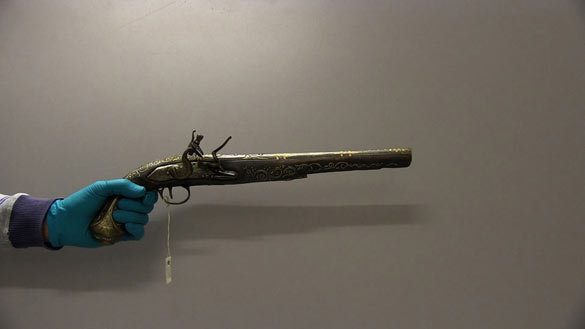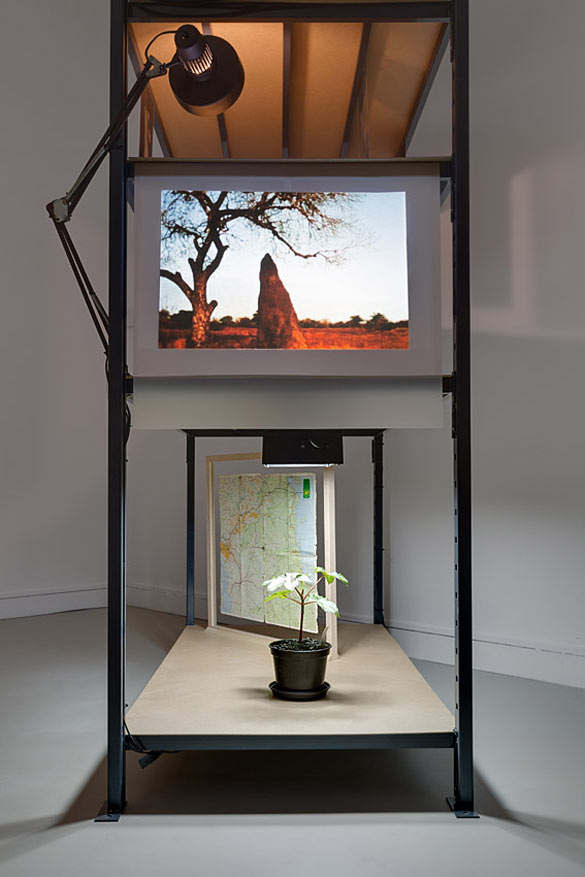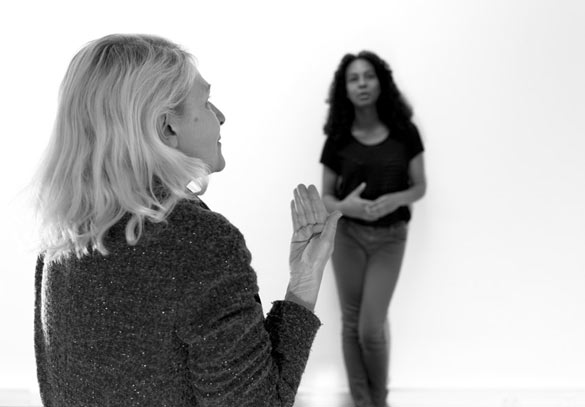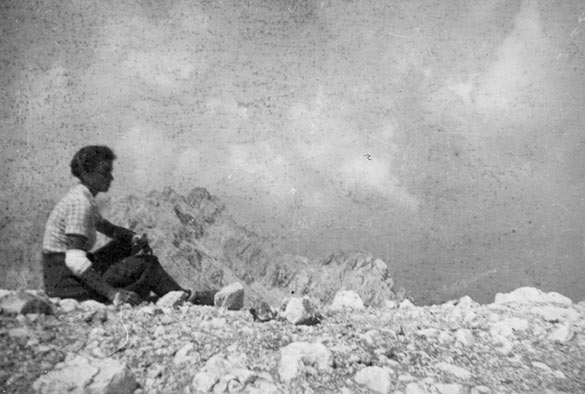Entretien avec Natasa Petresin-Bachelez

Commissaire invitée du programme Satellite du Jeu de Paume 2014, Nataša Petrešin-Bachelez a placé l’ensemble de son projet sous le signe de l’empathie. À travers l’invitation faite à quatre artistes, elle explore les modalités de réception de ce sentiment, cherchant à se détourner du discours ambiant qui consiste à vouloir installer les protagonistes dans des situations stéréotypées, alors qu’une nouvelle approche, issue des études postcoloniales et féministes, cherche à replacer cette relation dans une configuration élargie où ses déterminants sont interrogés à l’aune des antécédents historiques et des situations en présence ; ces recherches alternatives sur l’empathie ont par ailleurs des conséquences généralisables à l’ensemble des relations où il est question de domination, au-delà du terrain postcolonial, même si ce dernier se révèle particulièrement propice à la remise en cause de l’allant de soi. Ce qui nous intéresse ici, dans le cadre d’une série de propositions au sein d’une institution, c’est la manière dont la commissaire, par son choix d’artistes, cherche à mettre en relief et en polémique les occurrences d’un sentiment complexe pouvant se manifester de multiples manières entre les différents acteurs concernés, y compris entre le commissaire, les artistes et le contexte de l’exposition.
Patrice Joly : Votre sélection d’artistes pour le programme Satellite du Jeu de Paume est basée sur l’exploration de l’empathie en tant que sujet d’un discours émergent au sein de la sphère des relations sociales, comment avez-vous procédé pour réunir ces quatre jeunes artistes qui travaillent sur ce segment pour le moins spécifique ?
Nataša Petrešin-Bachelez : Suite à mon expérience de commissariat collectif aux Laboratoires d’Aubervilliers (2010-2012), cette invitation en tant que commissaire attitrée du programme Satellite du Jeu de Paume m’a posé quelques difficultés. J’ai donc décidé de transférer le potentiel fourni lors de l’intense collaboration avec la petite équipe des Laboratoires vers le montage d’expositions individuelles avec chaque artiste. Ce faisant, je me suis rendue compte que j’étais en train de creuser le potentiel qu’offre un poste institutionnel à valeur empathique. D’ailleurs, je continue à explorer ce principe d’échange empathique en situation discursive dans le cadre du séminaire « Something You Should Know » à l’EHESS avec Patricia Falguières et Elisabeth Lebovici. Il s’agit d’empathie de la part du commissaire, qui cherche à modérer ce « moment où l’on est affecté et où l’on partage l’état émotionnel de l’autre, puis où l’on évalue les raisons de cet état pour enfin s’identifier à l’autre en adoptant son point de vue ». On doit cette description de l’empathie au primatologue Frans de Waal (L’âge de l’empathie, 2010). J’ai choisi ces quatre artistes après avoir évalué quels travaux m’avaient personnellement fait forte impression plus ou moins récemment. En approfondissant davantage les discussions, questionnements et tentatives de compréhension des points de vues, volontés et convictions des artistes, j’ai atteint un nouveau champ de recherche sur la notion d’empathie : celle dans laquelle se trouve l’artiste lorsqu’il ou elle se penche sur un sujet spécifique. La capacité critique, l’autoréflexion et l’observation d’un affect fluctuant constituent un aspect important de leur travail.

Kapwani Kiwanga, Maji Maji, 2014. Pistolet. Collection d’Afrique orientale, Ethnologisches Museum, Berlin. Pistol. East Africa collection, Ethnologisches Museum, Berlin. Photo : Kapwani Kiwanga.
Un texte de Carolyn Pedwell que vous m’avez aimablement conseillé fait état de la préemption (ou de la déviation) de l’empathie par le discours libéral à des fins destinées à panser les blessures de l’Histoire (dans le cas des relations post-coloniales) mais en en minorant les traumas irréductibles, en ignorant par exemple l’impossibilité de faire le deuil d’une Histoire confisquée. Pensez-vous que l’art puisse contribuer efficacement à jeter un regard nouveau sur ce qui constitue la complexité d’un sentiment qui, bien souvent, repose sur des présupposés erronés, comme est capable de le faire la littérature avec un roman comme celui de Jamaica Kincaid, Small Place, qui met en lumière l’insistance du discours libéral ou néolibéral à vouloir considérer l’empathie comme une émotion simplement « positive ».
N P-B : Les recherches menées par Carolyn Pedwell et Clare Hemmings au cours des dernières années, à l’instar de Chandra Mohanty avant elles, fournissent un très bon aperçu de ce que sont l’empathie, les théories féministes transnationales et le lien entre la solidarité et l’empathie. Elles ont également brillamment présenté les dangers que peut engendrer l’empathie d’un sujet pour un autre, le premier venant souvent d’un milieu privilégié. Il s’agit d’une façon d’asseoir un pouvoir, avec le risque de voir le moins privilégié s’enliser dans son statut d’objet d’empathie, sans autre hiérarchisation possible. Dans l’exemple fourni par le texte de Carolyn Pedwell que vous citez, l’auteur se demande comment utiliser comme matière de travail les affects produits par et dans les archives des anciennes colonies ainsi que ceux ressentis au quotidien dans ces mêmes régions. De nombreuses disciplines artistiques proposent cette approche, mais je préfère toujours l’aborder de façon plus spécifique : qui est l’artiste, à qui s’adresse-t-il/elle, quels sont les liens, émotions, antagonismes ou processus qui en découlent ? Il y a en ce sens un fil conducteur entre les quatre points de vue artistiques des « Histoires d’empathie », mais j’aimerais qu’elles soient également évaluées à travers leur contexte d’origine et leur public cible.

Vue de l’exposition / exhibition view « Kapwani Kiwanga. Maji Maji », Satellite Programme 7, Jeu de Paume. 03/06 – 21/09/2014. Photo Romain Darnaud-Jeu de Paume.
C’est vrai que le rapport de ces quatre artistes à l’empathie apparaît d’autant plus remarquable qu’il est extrêmement divers dans sa restitution formelle, passant de l’exploration du format filmique chez Nika Autor à l’installation in situ chez Natascha Sadr Haghighian (et quel in situ !), de la performance chez Kapwani Kiwanga à la chorégraphie chez Eszter Salomon : est-ce à dire que vous cherchez à montrer que cette question de l’empathie devient véritablement pivot à l’intérieur de la pratique contemporaine et va bien au-delà des différenciations formelles, en privilégiant l’implication personnelle et affective vis-à-vis du sujet traité, en incluant le public et le contexte ? N’y a-t-il pas, d’une certaine manière — différente dans la forme et tenant compte de l’héritage des cultural studies – une volonté de refonder ou de rechercher une nouvelle « esthétique relationnelle », en moins ethnocentrée, plus ouverte sur les discours de l’émancipation, sur les scènes émergentes ?
N P-B : Cela fait maintenant longtemps que l’on rencontre, dans l’art contemporain et la performance, un usage poreux, discursif et situationnel des médiums et du corps. Je ne vais pas sous-entendre que ces quatre points de vue artistiques se rattachent à une certaine recherche sur la forme contemporaine dans l’art car pour moi, cela va de soi. En outre, au cours de ma pratique curatoriale, jamais je n’ai cherché à prétendre ou affirmer que les projets que je supervise ou auxquels je me consacre soulignent des positions et pratiques artistiques « émergentes », « imminentes » ou « nouvelles », celles-ci étant presque toujours mues par les forces et activités du marché de l’art ou par la communication qui l’entoure. C’est en ce sens que l’empathie et la compassion, qui représentent selon moi les qualités humaines essentielles à la résistance et à la survie globale des générations futures – mais qui doivent, comme toute autre capacité humaine, être vues d’un œil critique –, sont au cœur de mon programme Satellite, puisque c’est à travers la conception d’expositions et les efforts artistiques que nous pouvons les appréhender de façon polémique et non pas systématiquement affirmative. J’aimerais surtout que l’on comprenne ces points de vue autrement que comme un recyclage du terme galvaudé « esthétique relationnelle », qui possède sa propre histoire et sa propre contemporanéité dans les domaines de l’art et de la théorie. Cela dit, l’émancipation d’un sujet et la manière dont un processus de réception et d’échange peut l’y conduire – que cela concerne l’art entre objets et sujets, seulement entre sujets, ou dans d’autres situations quotidiennes – m’intéresse profondément, et il me semble que mon travail dans le domaine artistique peut y contribuer de façon significative.
L’exposition de Natascha Sadr Haghigian à la Maison Bernard Anthonioz fait référence explicitement au texte de Benjamin, Sur le pouvoir d’imitation, texte qui s’achève sur une réflexion un peu nostalgique du philosophe, selon quoi l’ancien lien mimétique qui unissait l’homme et la nature aurait disparu, se serait cristallisé dans le langage. La proposition de l’artiste peut s’analyser comme une réflexion sur l’écologie en tant que source potentielle de récits après avoir été envisagée successivement comme science puis comme discours politique : est-ce là, selon vous, un des devoirs de l’art, que de réinterroger constamment notre place au sein de notre environnement, de l’univers, et de redonner à la nature un peu de ce caractère « enchanté » qui aurait totalement disparu, ployant sous les coups de boutoir du rationnalisme et de la logique du développement ?
N P-B : Dans bon nombre de ses projets, Natascha étudie les notions de similarité, de mimétisme et, par conséquent, de magie, comme celle des onomatopées à la source de toutes les langues ou celle de la similarité comme moyen de reconnaître quelque chose de familier chez l’autre, qu’il soit de nature animée ou inanimée, sujet ou objet, vivant ou apparemment mort. C’est à cette occasion que ses recherches l’ont menée aux écrits de Walter Benjamin sur la similarité, ainsi qu’à notre questionnement sur l’empathie en tant qu’acte à travers lequel les êtres humains peuvent être émus et émouvoir les autres. La magie est également au cœur du projet de Kapwani Kiwanga intitulé Maji Maji, dans lequel elle explore les systèmes de croyances dans le sud de la Tanzanie et la façon dont ces derniers ont modelé l’histoire récente du pays à travers la rébellion des Maji Maji. On pourrait décrire ce moment où l’on ressent de l’empathie comme quelque chose qui engendre une rupture de notre vision, de notre perspective et de notre réflexion, peut-être comme quelque chose de magique, lorsque rien n’est plus comme avant. C’est ce moment précis qui m’intéresse le plus en ce qui concerne le rôle de l’art dans cette période troublée de notre histoire contemporaine : ce moment où l’on s’interroge sur nos croyances et nos connaissances, sur nos sentiments et sur ce que nous pourrions faire pour changer les idées reçues.

Eszter Salamon, 1949. Photo : Adrien Chevrot – Jeu de Paume.
Il arrive que les événements politiques se mêlent d’un projet artistique sans y avoir été invités (et résonnent de manière inattendue avec des « histoires d’empathie ») : la séquence qui se joue à l’autre bout de l’Europe entre la Russie et l’Ukraine repose la question de la participation à une manifestation qui risque d’avoir pour effet de banaliser une situation problématique. Si vous n’êtes pas directement liée à la programmation de Manifesta 2014 qui aura lieu cette année à Saint-Pétersbourg, ville de naissance de Vladimir Poutine, vous êtes associée à Manifesta via votre rôle de rédactrice en chef de son Journal. Que vous inspire ce genre de réflexion : « boycotter Manifesta, c’est priver la scène artistique russe de la possibilité de la faire sortir de son isolement, c’est rater une occasion de dialoguer avec un régime autoritaire ? »
N P-B : Le Manifesta Journal, pour les six derniers numéros duquel j’occupe le poste de rédactrice en chef, a été fondé comme journal indépendant de réflexion sur les pratiques curatoriales et artistiques contemporaines. Le dernier numéro, qui, comme vous l’avez précisé, n’est pas lié à l’édition de Manifesta à Saint-Pétersbourg et sortira courant octobre, sera réalisé en collaboration avec la commissaire Lisa Mazza et le commissaire et artiste David Riff, également membre du collectif Chto Delat? qui a décidé de ne pas donner suite à l’invitation de Kaspar König à participer à Manifesta. Les pétitions et appels au boycott de Manifesta ont évidemment influencé le ton de notre ligne éditoriale, dont les fils conducteurs seront les problématiques suivantes : comment créer dans de telles conditions de tourmente politique et sociale générale, et ce au-delà de la Russie et de l’Ukraine ? Comment sommes-nous conditionnés et comment tenter de nous déconditionner en luttant contre la censure dans ce genre de situation ? Comment adapter la complexité du contexte à la question du boycott, sans que celui-ci se résume au simple choix manichéen de participer ou de ne pas participer ? L’art contemporain est étroitement lié aux sociétés contemporaines, à la politique, à l’économie, aux spéculations financières, à la crise, mais également aux guerres, à l’argent sale et aux relations douteuses, et c’est pour cette raison que je reste consciente de la complicité de mes actes à chaque étape de mon travail de commissaire et de rédactrice. Ainsi, je suis en mesure d’aborder ouvertement cet aspect dans le contenu que je produis à l’intérieur de cadres donnés.
In conversation with Natasa Petresin-Bachelez
As the guest curator for the Satellite programme of Jeu de Paume 2014, Nataša Petrešin-Bachelez has devoted the entire project to the theme of empathy. Through the works of the four artists she invited, she explores the ways in which this feeling is received and seeks to move away from the common discourse, which consists in wanting to maintain the protagonists in stereotyped situations although a new approach, derived from postcolonial and feminist studies, tries to return this relationship to a wider configuration where its determining factors are questioned in the light of historical antecedents and present situations. Besides, these alternative research methods on empathy have consequences that can be applied to all relationships where domination is involved, beyond the field of postcolonialism, even if the latter happens to be particularly conducive to a reassessment of the obvious. What interests us here, in the context of a series of propositions made within an institution, is how the curator chooses artists in order to highlight and question the occurrences of a complex feeling that can take on very diverse manifestations depending on the players involved, including the curator, the artists, and the context of the exhibition.
Patrice Joly : Your selection of artists for the Satellite programme is based on the exploration of empathy as the subject of an emerging discourse in the field of social relationships. How did you proceed to bring together four artists who actually work on this specific subject?
Nataša Petrešin-Bachelez : After a collective directorship at Les Laboratoires d’Aubervilliers (2010-2012), the invitation to choose projects for the Satellite programme at the Jeu de Paume as an invited ‘solo curator’ was slightly troublesome for me. I therefore decided to transfer the potential of the intense collaboration within a small-scale team that I acquired from the experience at the Laboratoires onto the process of exhibition making with one artist at time. I realised that I was semi-consciously “researching by doing” the potential of an empathic institutional position. And I continue to explore empathic exchange in a discursive situation together with Patricia Falguières and Elisabeth Lebovici at the seminar ‘Something You Should Know’ at the EHESS. This is empathy from the side of the curator, when searching how to mediate that “moment of being affected by and sharing the emotional state of the other, assess the reasons for the other’s state and identify with the other, adopting her or his perspective”. This description of empathy was penned by primatologist Frans de Waal (The Age of Empathy, 2010). The choice of the four artists came after having assessed which artistic work recently moved me more or less strongly. Further discussions, questioning and understanding of these artists’ positions, desires and convictions led to another field of research into the notion of empathy, the one in which an artist finds him/herself when researching and working on a particular subject matter. Employing criticality, self-reflexivity, and observation of a modulating affect have an important role in their work.
A text by Carolyn Pedwell that you kindly recommended talks about the way liberal discourse pre-empts (or deviates) empathy in order to heal the wounds of History (in the case of postcolonial relations), yet tends to downplay the importance of irreducible trauma by ignoring, for instance, the impossibility to mourn a part of History that has been suppressed. Do you think that art could provide an effective way of shedding new light on what constitutes the complexity of a feeling which very often rests on false preconceptions, as a novel such as Jamaica Kincaid’s Small Place manages to achieve by pinpointing the manner in which the liberal and neoliberal discourse insists on considering empathy as a purely ‘positive’ emotion?
N P-B : Carolyn Pedwell, along with Clare Hemmings through the research they undertook for the past few years and, prior to them, Chandra Mohanty, offer important insight into empathy, transnational feminist theory and the relationship between solidarity and empathy. They have also argued very convincingly about the dangers of a subject feeling empathy for another subject, with the former often coming from a privileged social position. It is a way of asserting power, the danger thus being that the less privileged simply remains the object of empathy and is fixed in this hierarchy as such. In the example that you put forward, in Pedwell’s text, the whole question of how to deal with the affects that are produced in and around the archives in the former colonies as well as with the affects produced on daily basis in the same regions, and how to deal with them as a material to work with, is brought forward. Many of art’s various disciplines can offer that turn indeed, but I am always interested in talking about it on a specific level: who is the artist, whom is s/he addressing, what relations, emotions, antagonisms or processes are being produced. In that sense, there is a red thread linking the four artistic positions of “Tales of Empathy”, but I wish they were also assessed in regards to the context from which they come and to whom they are addressing.

Natascha Sadr Haghighian, Similar, 2014. Photographie de tournage / Production shot. Photo : Germain Ferey.
It’s true that these four artists’ relationships with empathy seem all the more remarkable in view of the extreme diversity with which it is formally rendered, ranging from Nika Autor’s exploration of the cinematic format to Natascha Sadr Haghighian’s in situ installation (and what an in situ!), and from Kapwani Kiwanga’s performance to Eszter Salomon’s choreography: does this mean that you are trying to demonstrate that this question of empathy truly becomes pivotal within contemporary praxis and reaches far beyond formal differentiations by favouring personal and affective implication towards the subject addressed and including the public and context? Isn’t there, somehow – in a different form that takes the legacy of cultural studies into account –, a will to recreate or search for a new ‘relational aesthetics’ – less ethnocentric, more open to emancipatory discourse and emerging scenes?
N P-B : For a very long time now in contemporary as well as in performance art, we have encountered porous, discursive and situated uses of media and of the body. It is not my intention to imply that these four artistic positions relate to a certain research of the contemporary form in art. I take it as a matter of fact. Furthermore, in my curatorial practice, I have never been interested in pretending or claiming that the projects I curate or work on underline artistic positions and practices that are ‘emergent’, ‘upcoming’, or ‘new’, which are almost always driven either by the forces and activities related to the commercial art market or by communication around art. In that sense, empathy and compassion, which are in my view essential human capacities for resilient living and the general survival of generations to come, but have to be viewed, as any other human capacities, critically, are at the heart of my Satellite programme because through exhibition making and artistic endeavour we can discuss them polemically and not just affirmatively. Above all, I would not like to see these positions understood as a renewal of the overused term “relational aesthetics”, which has its own history and contemporaneity in art and theory. However, the emancipation of a subject and how a process of reception and exchange can lead to it, whether usually in art between objects and subjects, but also among subjects, or in other daily situations, is what deeply interests me and where I feel that working within the field of art can contribute to this in a meaningful way.

Nika Autor, Slava Klavora dans les montagnes de Kamnik, été 1938. Photographie d’archives utilisée dans Newsreel 55 / Archive document used in Newsreel 55 de / by Nika Autor, Marko Bratina, Ciril Oberstar et Jurij Meden, 2013. Colection du / Property of National Liberation Museum Maribor.
Natascha Sadr Haghighian’s exhibition at the Maison Bernard Anthonioz explicitly refers to Benjamin’s essay On the power of imitation, which the philosopher ends with the somewhat nostalgic thought – that the mimetic bond between mankind and nature has disappeared and become crystallized in language. The artist’s proposition could be interpreted as a reflection on ecology as a potential source of stories, after having been successively considered a science and a political discourse: according to you, is one of art’s duties to constantly question our place in our environment and in the universe, and to bring some ‘enchantment’ back to nature where it might have disappeared altogether under the yoke of rationalism and development logic?
N P-B : In many of her projects, Natascha has been researching the notions of similarity and mimicry, and consequently of magic, for example of onomatopoeia as the source of all languages or of similarity as a capacity to recognize something familiar in the other – of animate or inanimate nature, subject or object, alive or seemingly dead. This is where her research brought her to Walter Benjamin’s texts on similarity and also to our discussion on empathy as an act where humans are moved or can move others. Magic is also at the heart of Kapwani Kiwanga’s project Maji Maji, where she explores belief systems in south of Tanzania and the ways they shaped the recent history of the country through the Maji Maji insurrection. The moment when one feels empathy can be described as something that causes a rupture in our vision, perspective, thinking, as something perhaps magical, when nothing is as it was before at that moment. It is precisely this moment that I am most interested in when thinking about the role art can play in these very troubled times of our contemporary civilisation; when we are questioned about what we believe in and know about, how we feel and what we could do to change established ways of thinking.
Sometimes, political events interfere in art projects without the least invitation – and unexpectedly echo ‘stories of empathy’: what is happening on the far side of Europe between Russia and Ukraine rekindles the issue of taking part in an event that might lead to the trivialisation of a problematical situation. Although you have no direct connection to the programme of Manifesta 2014, which will take place in Vladimir Putin’s hometown Saint Petersburg, your role as chief editor of its Journal links you to the event. What are your thoughts about the following remark: “boycotting Manifesta means depriving the Russian art scene of the possibility of escaping isolation. It means missing an opportunity to communicate with an authoritarian regime”?
N P-B : The Manifesta Journal, for the six last issues of which I was the chief editor, was established as an autonomous journal to reflect on contemporary curatorial and artistic practices. The latest issue, which is, as you mention, not part of the Manifesta Biennial in St Petersburg and will come out in mid-October, will be put together in collaboration with curator Lisa Mazza and curator and artist David Riff, also a member of the collective Chto Delat?, which decided to withdraw from taking part in the Biennial on the invitation of its curator Kaspar König. The petitions and calls for the boycott of the Manifesta Biennial have naturally shaped our editorial atmosphere, where the guideline will be the following questions: how can one work in such conditions of intense political and social turmoil, anywhere, not only at the moment in Russia or Ukraine? ; how is one conditioned and does one attempt to decondition oneself by working against self-censorship in such situations; how to articulate the existing complexity with the question of boycott and not just the black and white image of « being part of it or not being part of it » ? Because contemporary art is entangled as a constitutive part of contemporary societies, politics, economy, financial speculations, crisis, but also wars, dirty deals and interpersonal relations, I am aware of the complicity of my acts in every step I take as a curator or editor, and I try to tackle them openly in the content that I produce within given frames.
- Partage : ,
- Du même auteur : Jack Warne, Yan Tomaszewski, Alun Williams, Ben Thorp Brown, Mircea Cantor,
articles liés
Céleste Richard Zimmermann
par Philippe Szechter
Julien Creuzet
par Andréanne Béguin
Anne Le Troter
par Camille Velluet

